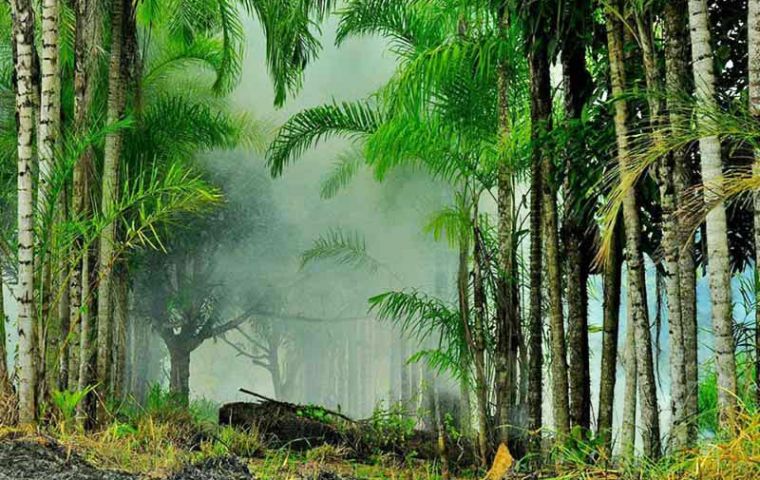MercoPress. South Atlantic News Agency
A forest area equivalent to South Africa has been lost since 1990, says FAO
 An increasing amount of forest areas have come under protection while more countries are improving forest management.
An increasing amount of forest areas have come under protection while more countries are improving forest management.  Africa and South America had the highest net annual loss of forests in 2010-2015, with 2.8 and 2 million hectares respectively
Africa and South America had the highest net annual loss of forests in 2010-2015, with 2.8 and 2 million hectares respectively  “Forests play a fundamental role in combating rural poverty, ensuring food security and providing people with livelihoods” said José Graziano da Silva
“Forests play a fundamental role in combating rural poverty, ensuring food security and providing people with livelihoods” said José Graziano da Silva The world's forests continue to shrink as populations increase and forest land is converted to agriculture and other uses, but over the past 25 years the rate of net global deforestation has slowed down by more than 50%, FAO said in a report published on Tuesday.
Some 129 million hectares of forest - an area almost equivalent in size to South Africa - have been lost since 1990, according to FAO's most comprehensive forest review to date, The Global Forest Resources Assessment 2015.
It noted however, that an increasing amount of forest areas have come under protection while more countries are improving forest management. This is often done through legislation and includes the measuring and monitoring of forest resources and a greater involvement of local communities in planning and in developing policies.
The FAO study covers 234 countries and territories and was presented at this week's World Forestry Congress in Durban, South Africa.
“Forests play a fundamental role in combating rural poverty, ensuring food security and providing people with livelihoods. And they deliver vital environmental services such as clean air and water, the conservation of biodiversity and combating climate change,” said FAO Director-General José Graziano da Silva, launching the report in Durban.
He noted an “encouraging tendency towards a reduction in rates of deforestation and carbon emissions from forests,” as well as improved information that can inform good policy, noting that presently national forest inventories cover 81% of global forest area, a substantial increase over the past 10 years.
While in 1990 forests made up 31.6% of the word's land areas, or some 4 128 million hectares, this has changed to 30.6% in 2015, or some 3 999 million hectares, according to FRA.
Meanwhile, the net annual rate of forest loss has slowed from 0.18% in the early 1990s to 0.08% during the period 2010-2015.
Today, the bulk (93%) of the world's forest area is natural forest - a category that includes primary forest areas where human disturbances have been minimized, as well as secondary forest areas that have regenerated naturally.
Planted forest, another subcategory, currently accounts for 7% of the world's overall forest area, having increased by over 110 million hectares since 1990. FAO's report stresses the critical importance of forests to people, the environment, and the global economy.
The forest sector contributes about $600 billion annually to global GDP and provides employment to over 50 million people.
Africa and South America had the highest net annual loss of forests in 2010-2015, with 2.8 and 2 million hectares respectively, but the report notes how the rate of loss has “substantially decreased” from the previous five year period.
Since 1990 most deforestation has taken place in the tropics. In contrast, net forest area has increased in temperate countries while there has been relatively little change in the boreal and subtropical regions.
However, given global population growth, average per capita forest area has predominantly declined per person in the tropics and subtropics, but also in all the other climatic regions with the exception of the temperate.
Currently, forest area primarily designated for biodiversity conservation accounts for 13% of the world's forest, or 524 million hectares, with the largest areas reported in Brazil and the United States.




Top Comments
Disclaimer & comment rules-

-

-

Read all commentsThe world runs to self-destruction.
Sep 09th, 2015 - 07:24 pm 0We need to stop this erosion by a rapacious system that only cares about monetary profits.
The value of trees should include their ecological functions--not only their dead wood yields.
Let's do it before it's too late.
Stop the corupt goverments from letting these companies tear down the forest.
Sep 09th, 2015 - 09:49 pm 0We will develop the Brazilian forests. Has a lot of wealth to be exploited!
Sep 09th, 2015 - 11:16 pm 0The important thing is not to let people and Western capitals. Expel foreign NGOs is paramount.
Commenting for this story is now closed.
If you have a Facebook account, become a fan and comment on our Facebook Page!